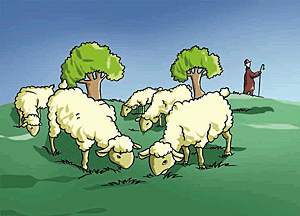phytophagous, phytophage, phytophagy
Feeding on plants or on plant material.
 These sheep are prime examples of phytophagy.
These sheep are prime examples of phytophagy.
phytopharmacology
1. The applications of plant physiology to medical problems.
2. The study of major constituents (active ingredients) and medicinal values of plants; toxicity or hazardous components; essential oils; value-added products and possible uses; cultivation and harvesting; diseases and insects found in medicinal plants.
3. The study of the active chemicals in plants that effect our biological systems. The plants' chemical components are studied for medical and psychoactive reactions.
Many of the chemicals of plants mimic our own bodily chemicals and in some instances enhance the normal reactions that would occur; however, sometimes they block the normal functions of our neural and other cellular functions. These are factors that must be evaluated in the phytopharmacological research of plants.
phytophilist
(s) (noun), phytophilists
(pl)
A collector of plants: Jack loved botany and wanted to have as many kinds of plants, like flowers, shrubs, bushes, and trees, in his garden as possible, and his friends said that he certainly was a phytophilist.
Referring to an organism that exists in the proximity of plants: Some phytophilous animals that live close to vegetation and graze on grass are cows and buffaloes, and, of course, some small creatures, like squirrels and mice also feed on plants.
phytoplankton
(s) (noun), phytoplanktons
(pl)
Planktonic plant life:
Phytoplanktons typically comprise suspended microscopic algai cells, such as diatoms (unicellular organisms) and desmids.
The phytoplanktons consist of small plants having very limited powers of locomotion or no movement at all. They are mostly subject to distribution by water movements and they photosynthesize, producing the first level in an ocean's food chain.
Certain planktonic algae move by means of flagella, or possess various mechanisms that alter their buoyancy. Most algae are slightly denser than water, and sink into the sediment of the water.
Phytoplanktons are largely restricted to lentic ("standing") waters and large rivers with relatively low current velocities.
phytoproterandrous
The condition of having ripe pollen before the stigma is receptive.
phytoproterogynous
Having the styles of a flower mature before the pollen ripens.
Phytosaurus
“Plant lizard” from Late Triassic Europe. Named by Georg Friedrick von Jaeger in 1828.
phytosociologist
Someone who specializes in that aspect of ecology dealing with the origin, composition, structure, and classification of plant communities.
phytosociology
The branch of ecology that deals with the characteristics, classification, relationships, and distribution of plant communities.
phytosuccivorous
To eat by sucking the sap of plants.
phytotaxis
The arrangement of leaves.
phytotelmata
Small pools of water in or on plants, such as the leaf bases of bromeliads or the pitcher of pitcher plants.



